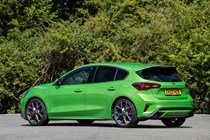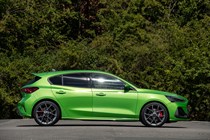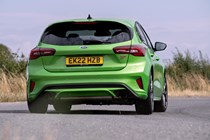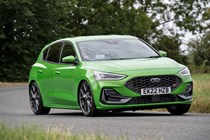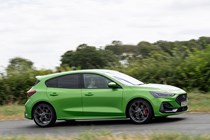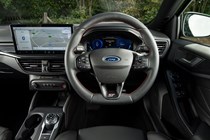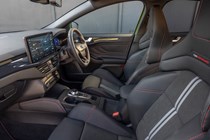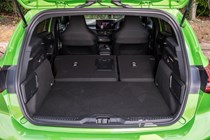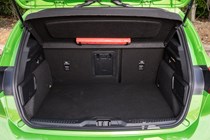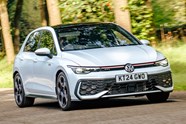Ford Focus ST review
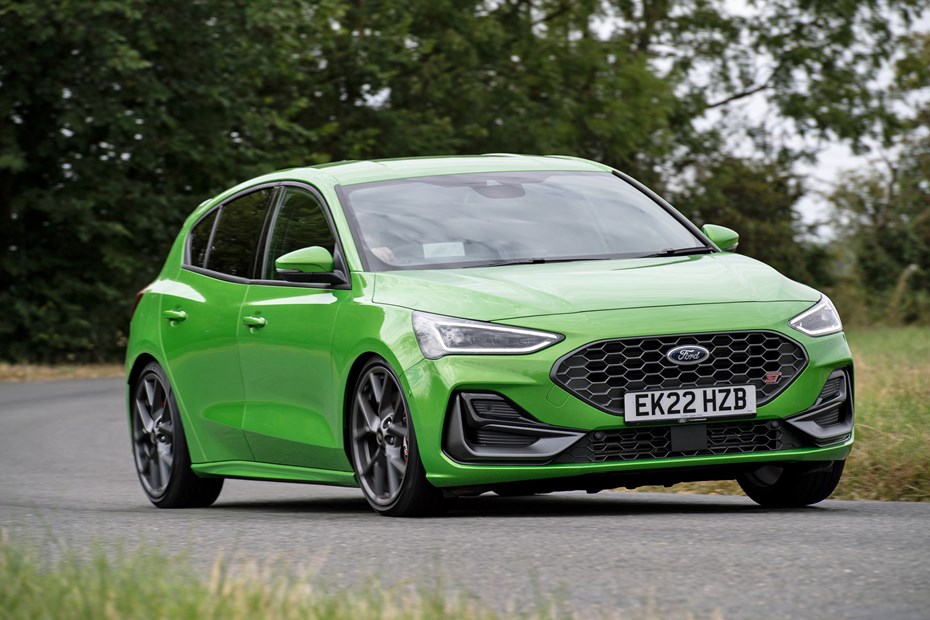
At a glance
| Price new | £38,800 - £44,000 |
|---|---|
| Used prices | £11,730 - £31,937 |
| Road tax cost | £195 - £620 |
| Insurance group | 23 - 34 |
Get an insurance quote with

|
|
| Fuel economy | 34.9 - 53.3 mpg |
| Range | 377 miles |
| Miles per pound | 5.1 - 6.8 |
| Number of doors | 5 |
| View full specs for a specific version | |
Available fuel types
Petrol
Diesel
Pros & cons
- Entertaining to drive
- Spacious rear seats
- Plenty of standard equipment
- Faster rivals are available
- Quite expensive now
- Could be nicer inside
Ford Focus ST rivals
Overview
Should you buy one?
If driving thrills are at the top of your list of priorities but you still need a thoroughly practical family car, the Ford Focus ST hot hatch is well worth a look. It’s got plenty of space inside for passengers, and the estate version offers extra boot space if the hatchback isn’t big enough.
However, competition is fierce. For example, the Volkswagen Golf GTI is classier (especially inside) and the Hyundai i30 N is even more exciting – especially as the Focus doesn’t always feel as fast as 280hp suggests it should do.
We’d suggest a lengthy test drive of every rival before you finally take the plunge, though as an all-rounder the Focus ST certainly isn’t short of appeal. Comfort levels are just the right side of tolerable, you get loads of standard kit, and this is an easy car to handle whether you’re cruising through town, covering distances on the motorway or hacking along your favourite backroad.
What’s new?
If you’re after an old-school hot hatch, the Ford Focus ST could be right up your street. It does without complicated four-wheel drive systems and hybrid assistance to deliver rowdy fun and a dollop of practicality on the side. After a 2022 refresh the range has been slimmed down to a single 280hp petrol engine with manual or automatic gearbox in hatchback or estate flavours.
Updates to the Focus ST include a taller nose and larger front grille, incorporating the Ford badge (instead of the bonnet), while slimmer LED headlights are fitted. There’s a new Mean Green paint option, and some changes to the alloy wheel designs. Highlights on the inside include the latest Ford Sync 4 infotainment system and new Ford Performance seats.
You can still add the Performance Pack for a couple of go-faster features, but now there’s a more extreme Track Pack. This is significantly more expensive, adding manually adjustable coilover suspension, bigger Brembo brakes, lighter alloy wheels with stickier tyres and a Track mode. A black roof, mirrors and rear diffuser mark them out externally.
It’s not the bargain it once was, although it still undercuts the hottest Cupra Leon, the Volkswagen Golf GTI and BMW M135i. However, the Hyundai i30 N undercuts all of them despite offering some of the biggest grins. Or for ultimate hot hatch thrills in a smaller package, consider the Parkers Awards-winning Toyota GR Yaris – which offers 261hp and four-wheel drive, assuming you can find one.
What’s it like inside?
Gone are the Recaro sports seats of the pre-facelift Focus ST, replaced by a set of Ford Performance-developed alternatives that are a little wider and shallower of bolster. Ahead of the driver is an ST-specific steering wheel, complete with lots of buttons – including one that directly accesses the Sport driving mode – and a set of paddleshifters if the optional automatic transmission is specified; these are small and rather cheap-feeling, which is a disappointment.

A part-metal gearlever (on manual-gearbox models; the auto gets a basic rotary controller) and some contrast red stitching finish off the sporty makeover. There’s plenty of standard equipment including dual-zone climate control and a Bang&Olufsen stereo upgrade. Sadly that climate control is no longer controlled by simple physical dials, you need to go into the touchscreen instead now.
The rest of the interior is familiar Focus, with quality proving passable but by no means opulent, and plenty of space for passengers. Those in the back get more leg room than in a Golf GTI and certainly a GR Yaris, and the boot isn’t bad, either. The Focus ST Estate isn’t as capacious as non-PHEV versions of the Cupra Leon Estate, but still far more practical than the hatch. For more information, have a look at our Ford Focus Estate review.
Infotainment and tech
Behind the wheel is an attractively-designed digital instrument cluster, which is relatively easy to navigate and clear to view. Above this is an optional head-up display, while alongside in the centre of the dashboard is a larger-than-ever 13.2-inch infotainment touchscreen. This runs Ford’s latest Sync 4 software, which is generally user-friendly even if there are some unusual interface decisions, with menus covering other menus in places.
Comfort
The new Ford Performance seats in the Focus ST have approval from the German Campaign for Healthier Backs, so should be ergonomically on point – we certainly had no issues over several lengthy journeys, and the multi-way adjustment means most should be able to find a comfortable driving position here.
The ride comfort is a different issue, which we’ll deal with in the driving section below.

Refinement is best described as okay. There’s a constant muted engine backing track that sounds somewhat artificial but stops short of being properly annoying. Some hot hatch buyers might even find the ST too quiet now, although you do still get some pops and crackles from the exhaust in the sportier driving modes. However, there is also quite a bit of road noise from the tyres, which can make longer journeys tiring – and sometimes requires the stereo to be turned up rather loud to drown it out.
Boot space and storage
With the rear seats in place, the Focus ST’s boot capacity falls just five litres short of the Volkswagen Golf’s at 375 litres. There’s 1,354 litres of storage space on offer if you fold the rear bench flat, although that’s 200 litres less than you get in the cavernous Skoda Octavia. So, if you value maximum storage space above all else, consider looking elsewhere.
Despite this, the Ford Focus’s boot is a good shape with minimal intrusion from the wheel housings. There is a small lip from the boot opening to the boot floor, so bear this in mind if you’ll be regularly carrying heavy items. Folded down in their standard 60:40 split, the rear seats sit almost flat and allow long items to be slid forwards with relative ease.
Cabin storage is a little stingy. The glovebox and the central armrest storage bin could be larger, and there aren’t any of the clever storage solutions you get in the Octavia. However, the door pockets are deceptively large and the central cupholder can now be adjusted to suit a range of drink sizes, which help make up for it.
Safety
As with the Focus range in general, the ST comes with all the safety equipment we expect these days – including autonomous emergency braking – and a couple of extra features to underline its position as the halo model.
For instance, in addition to lane departure warning you get lane keeping assistance (which is easy to deactivate if you’re not keen, and unlike some rival systems it stays off rather than reactivates every time you restart the car), and the LED headlights are ‘dynamic matrix’ items that give you maximum visibility at all times while avoiding dazzling other motorists. It’s fascinating to watch these in action at night.
The ST also comes with bigger brakes and tuned suspension for sharper responses, while the electronic limited slip differential helps the front-wheel drive chassis to maximise traction.
Engines
Following the facelift, the only Focus ST engine choice is a 2.3-litre turbo petrol with 280hp and up to 420Nm of torque; the optional seven-speed automatic transmission is restricted to 415Nm, but both this and the standard six-speed manual gearbox are now said to cover 0-62mph in 5.7 seconds.
The old 2.0-litre diesel alternative had just 190hp and required 7.6 seconds to go 0-62mph; we’re not mourning its loss.
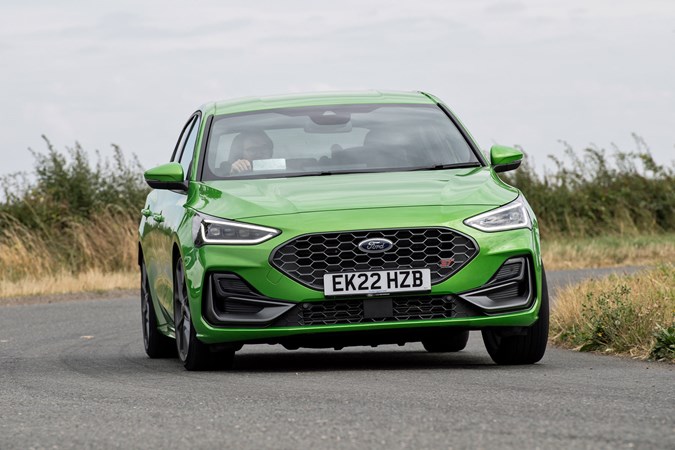
The Focus ST automatic transmission is pleasant enough, and will be welcomed by those who often find themselves stuck in traffic. But the equivalent Golf GTI auto offers sharper reactions, and the Ford is undoubtedly at its most engaging where the manual gearbox is fitted. For without this direct ability to take control of the 280hp engine, performance can feel strangely flat at times.
What’s it like to drive?
This is a taut and agile car, for sure – and closer in character to the GTI Clubsport than the regular Golf GTI due to higher compromises it demands in terms of ride comfort in exchange for its tighter body control in the corners. Even so, it’s easy and approachable when it comes to driving quickly, rather than spikey and aggressive, which means you soon find yourself falling into a rhythm with it over your favourite roads. It does sometimes seem like hard work before it really feels like its moving at its most fulsome, however.
On the plus side, it’s also not so firm on its 19-inch wheels that longer journeys become unthinkably punishing. Adding the optional Ford Performance Pack and the adjustable ‘Continuously Controlled Damping System’ helps tailor this aspect further. Though how long your passengers will tolerate the firmer setting will vary with their constitutions and the condition of their lower spine, this certainly adds a additional measure of immediacy and precision when travelling swiftly on smoother roads.
On bumpier ones, you’ll probably find yourself soon returning to the normal setting. Unlike the smaller Fiesta ST, the Focus never quite achieves the state of suspension nirvana that sees it skimming over bad surfaces at higher speeds, so the more comfortable suspension mode is a necessary compromise.
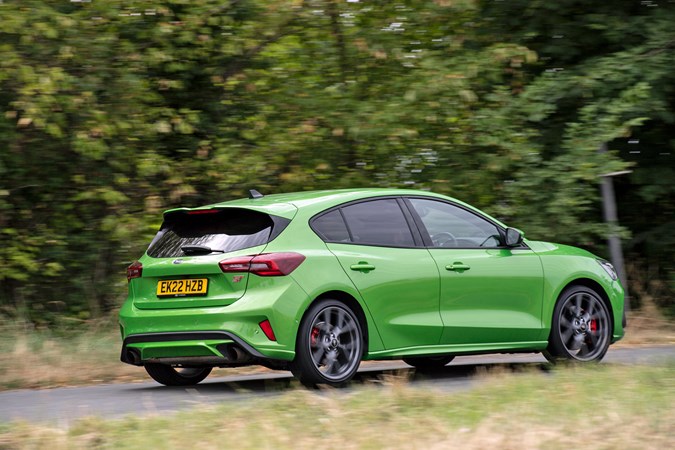
Similarly, if you’re expecting a driving experience like that of the Fiesta ST, only bigger, the Focus ST isn’t quite as playful – or preternatural – in its responses. There’s lots of grip, and the electronically controlled differential achieves a lot of traction, but the car doesn’t always react exactly as you were expecting, occasionally requiring a correction to the line you thought were taking through the corner.
At lower speeds, meanwhile, the way the chassis is set-up can result in the front end following the pitch of the road more than you were anticipating – and that’s at constant throttle, rather than when accelerating. You’ll feel the same sensation through the steering wheel when passing over the crown of the road as well.
It’s still lots of fun, and an impressive way to cover ground rapidly, with the Track Pack adding to this. It’s basically the same list of parts added to the pre-facelift Focus ST Edition and therefore drives in much the same way. The KW coilover suspension is even firmer than stock and can’t be adjusted without getting some spanners out.
You’re aware of every surface imperfection passing under you, yet the tightly controlled damping prevents it from feeling crashy and brittle. It feels keener to turn into a bend than the regular ST and grip levels are higher in the dry thanks to the uprated tyres. It’s not cheap, but for the track day enthusiast or those more interested in the hot than the hatchback it’s worth having.
Even so, the Hyundai i30 N delivers even more raucous thrills for thousands less.
What models and trims are available?
In the UK, the Focus ST is presently sold in a single variant. This can be upgraded with the Ford Performance Pack or Track Pack, but otherwise performance is fundamentally the same on every model. Elsewhere in Europe, the standard ST comes with smaller 18-inch wheels; it would be interesting to see what difference this would make to the ride on UK roads, but all cars sold here come on 19-inch wheels.
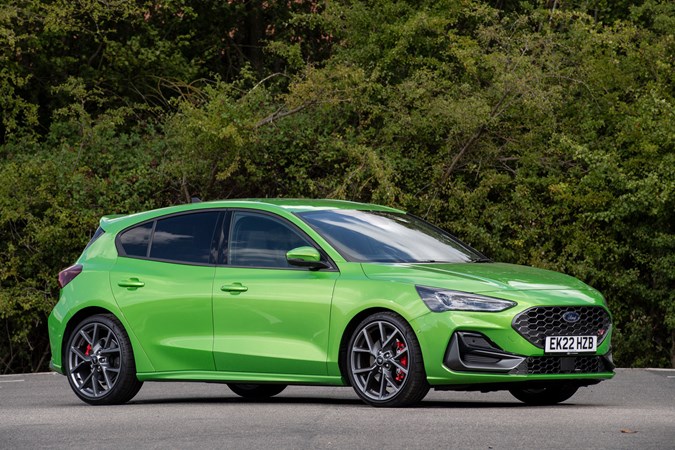
Keep reading for our full verdict on the Ford Focus ST.



